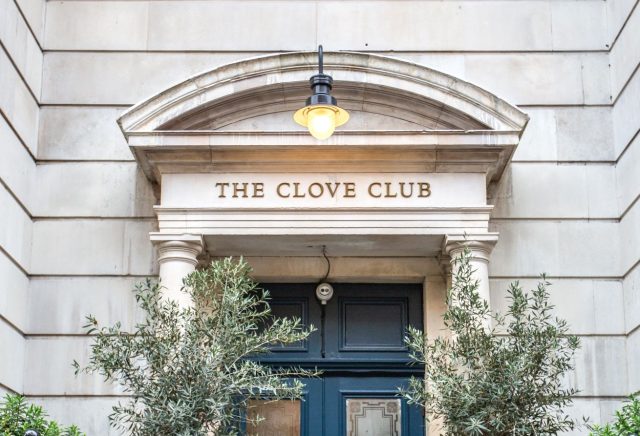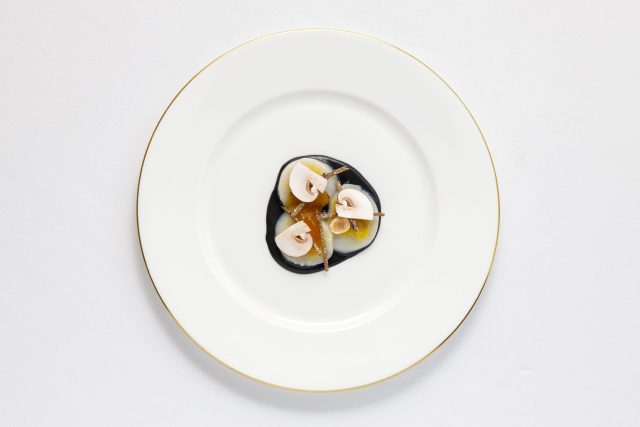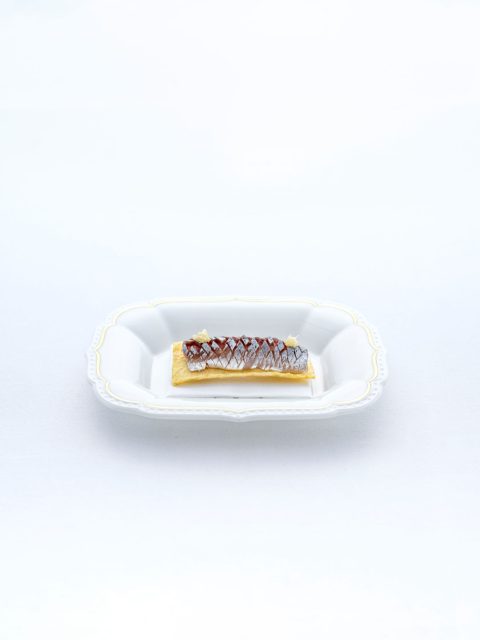db Eats: The Clove Club, Shoreditch
Douglas Blyde heads to what was once Shoreditch Town Hall but is now home to The Clove Club. While there, he explores the two Michelin-starred restaurant’s “masterful” and “memorable” tasting menu, and raises the question of why chef-patron Isaac McHale hasn’t written a book yet.

“The tasting menu is dizzyingly ambitious and rooted in impeccably sourced seasonal British produce” wrote Condé Nast Traveller’s Sonya Barber of The Clove Club, set in the former Shoreditch Town Hall beneath the statue of Progress, while The Telegraph’s Ben McCormack found “haute cuisine … brought to Shoreditch with a swagger of East London attitude.”
Design

Enter via the bar with spirits flights depicting, for example, “a history of fruit distillate” and cocktails dispensed from its saloon-style counter, including the miso vermouth enriched martini. With gallery-style lighting, the dining room is reached through a mosaiced hall equipped with several drinks fridges. Complete with a utilitarian clock, the focal, wholly open kitchen is blue-tiled, the hue which inspired design agency, Everything in Between, to create botanical cyanotypes on the reverse of postcards which describe each dish.
Drinks
McHale is equally fascinated by what goes in the glass as on the plate, even integrating venerable Madeira into particular dishes. He also holds a fondness for the wines of Gigondas, Nuit-Saint-Georges, and from Champagne, Pierre Péters, as well as Kongsgaard and Unico Zelo from the New World.
The large, often good value list, is overseen by Australian-born finance graduate turned head sommelier, Emer Landgraf, who landed in England in Spring 2022, having previously worked at Mosconi, Brisbane. Located in an old war igloo, that venue took its name from the famed Barolo vineyard in Monforte d’Alba.
By the glass, the wines of the near-mythic, Josko Gravner are presented in their own broad and tactile vessels. Other choices include Richard Kershaw’s Clonal Selection of Pinot Noir from Elgin, and by the measure, Madeira reaching as far back as 1900 (Moscatel Graudo D’Oliveiras).
Despite this two Michelin-starred restaurant being high on the World’s 50 Best list, over 120 bottles are available below £100 with Miranius Celler Credo from Penedès thrice marked up at £45. At the top end, choice bottles might include Château Mouton-Rothschild 1983 at approximately double mark up (£1,100), being a property where Landgraf undertook her first harvest, while Eisele Vineyard Cabernet Sauvignon from Calistoga 2014 is five times retail at £1,630, and Egly-Ouriet’s Ambonnay Grand Cru Brut Millésime 2008 is circa double (£1,990).
Interesting collections comprise Nicolas Joly’s Coulée de Serrant Savennières with its cult following, the wines of one of Austria’s oldest estates, Nikolaihof, and Frank Cornelissen’s explorations into the filmic Etna landscape. The strong USA selection reaches as far back as 1963 Charles Krug’s St. Helena Cabernet Sauvignon.
Progressively, white wines and Champagnes, are often offered at cellar temperature, while teas for pairing are both long brewed and served at room temperature. As per the majority of wines by the glass, these are poured in Jancis Robinson/Richard Brendon universal stemware, with their leaves presented before and after steeping in Petri-like dishes. The collaboration with Postcard Teas “opened my mind”, noted Landgraf.
Dishes
Scottish-born head chef-patron, Isaac McHale became a fishmonger at just fourteen, informing a lifelong fascination for ingredients and their producers. He went on to work at The Ledbury for six years, as well as Noma and Eleven Madison Park. With chef, James Lowe (Lyle’s), he launched the precursor to The Clove Club in the formative “Young Turks” pop-up above Spitalfields’ supposedly haunted pub, The Ten Bells.
Having been invited to cleanse hands with a bergamot-scented hot towel, the remarkable lunch, presented on specially commissioned Royal Crown Derby bone China, with David Mellor cutlery, began with “spicy” Meunier-rich Champagne from a Solera. Beyond its map-like label, Roger Coulon Heri-Hodie, Extra Brut was poured into neat Grassl Elemental stemware. Its location is “adjacent to Egly-Ouriet” in Vrigny, said Landgraf of the rustic style. This accompanied a dish defining green, being warm herb broth of tarragon, dill, clover, parsley, soy, and lovage, the latter “being the base of Maggi sauce” said the master of factoids, McHale. Other snacks included a roast pepper tart with fromage jelly, particularly tender, well seasoned, greaseless, buttermilk fried chicken, open Cornish crab dumplings with elderflower hollandaise and devilled spices, and a beetroot and apple gazpacho. This savoury pudding wove a subtle smoke – a recurring theme throughout the meal – from charcoal, alongside olive oil and tangerine. Despite Landgraf acknowledging “not many things work with that dish” the pairing proved a highlight.
Inspired by “trout amandine”, hence scented like a Battenberg slice, the first dish proper saw cold smoked, quickly baked Wiltshire trout, including its crisp skin, served with almond milk, prune kernel oil, watercress and Petrossian Oscietra caviar. This was finished with a hearty spoonful of toasted almonds which flowed like lava. Alongside, Landgraf chose the nutty, even slightly caramel-like Roussette de Savoie, L’Innocente 2021, being the second vintage (2021) reaped from a 1.5-hectare plot tended by agronomist engineer turned winemaker, Charlotte Sonjon.

Partner Content
First introduced in 2015, raw, sweet Orkney scallop with hazelnuts, clementine glaze, and a glossy black purée of English truffles, was finished with young, raw, sliced chestnut mushrooms, and a satisfying brown butter dressing. With this, Landgraf poured two similarly coloured liquids, London Roast Black Sun tea from old plants in Obayashi, Japan, and, even better, skin contact Radikon Slatnik from Friuli. The latter, from 2021, was encapsulated in the famous Josko Gravner glass. “Feel the energy”, Landgraf hummed.
Just returned from the Gastromasa congress on geography, global warming, and changing migratory in Istanbul, where he spoke on the return, after six decades, of tuna to warming Hebridean waters, McHale’s wowing next course, over two parts, celebrated what Countryfile called the “sleek turbo-athlete of the ocean.” First, belly of wild Scottish tuna tartare, briefly marinated in soy, featured a smoked oyster-infused house shoyu, walnut and Sarawak pepper condiment and Swiss chard stem and marjoram tempered with ricotta.
Next, having been presented for approval, and inspired by Piedmontese carne crudo, the loin was lightly grilled for barely 30 seconds, then coated in new season olive oil, with a julienne of caper leaves. An egg yolk sauce ensured the final component, an outrageously aromatic Istrian white truffle, was activated. Alongside, Tyrell’s Vat 1 Sémillon, 2016, with its dried lime and banshee-like acidity, was slightly too bright for this duet of acts of otherwise luxurious, pliant tuna and their complex accompaniments.
McHale’s culinary care with treasures of the sea continued with a rarely seen dish of supple sea bass collar marinated in soy for 24 hours, presented on an origami paper with a wedge of sopping, juicy sudachi. Deeply flavoursome, this, and the following dish was served with flamboyant, Viognier-like Hokkaido Junmai Daiginijo, TOKU, which wears a duality of east meets west labels. Alas, the albeit pretty choice of cups dulled the perfume of the sake, as if playing a favourite record through a Tannoy rather than top-notch speakers. Better to consign these to a cupboard of trinkets than the dining table.
Scored Cornish sardine sashimi was inspired McHale’s visit to the increasingly famous Sushi Iwase in Tokyo with his famous friend, Endo Kazutoshi. “I was nervous,” recalls McHale, “fish sardine, raw? Bloody hell, it was one of the best things I have ever eaten.” Complete with a ginger and chrysanthemum glaze, English mustard, and positioned atop a bridge-like crisp evoking gentrified salt and vinegar crips, the meticulously prepared fillet was so impeccably delicious that it arrested conversation. Like, we suspect, with so much of the cuisine of Japanophile, McHale, this acted in harmony with sake. Part two of the dish saw a cosy, smoked broth of the precisely filleted sardine bones fed with robust Craigellachie 13 Speyside Scotch.

Line caught pollock, grilled, with a Bouillabaisse of monkfish, red mullet, and rockfish, and cauliflower florets, while perfectly cooked, lacked the pyrotechnics of previous dishes. However, the vinous match, being an 11.5% Pais reaped from “200-year-old vines” said Landgraf, in Chile’s Biobío region, did up the tempo. Once known as the “Mission grape”, in the hands of Itata Valley producer, Roberto Henriquez, the result was intriguing. “I feel you could the drink whole bottle without knowing what is going on,” said Landgraf astutely, who “loves matching red with fish.”
“Gourmands favourite,” of veal sweetbreads, said McHale, was baked in “insulative” hay, with chanterelles, and offered with a bespoke Clove Club knife by Roland Lanier. This was finished with bay leaf emulsion and an “a la minute” sorrel sauce, providing “a nice acidic foil.” An addition of puffed grains ensured the highly aromatic, savoury, Yame Genmaicha tea pairing, featuring rice and sencha from the same organically tended plot in Yame, was complimentary. Vinously, Landgraf opted for a perhaps surprising match of incisive, low-dosage, Blanc de Blancs Champagne from the Côte de Blancs. Served notably cold, L’Aventure by Les Frères Mignon NV, is the new project by two siblings, cheerily depicted, one with wine thief in hand, on the label.
Raising the game once again, was the next “liquid course” intended to evoke “French cooking on the inverse,” said McHale. A very fine duck, morel and ginger consommé, was added, in the wine glass itself, to a measure of extraordinary Madeira. Drawn, by Portuguese server, Daniel, from a choice of 1908 Boal, 1969 Sercial, or Verdelho from 1986, using a baster-like pipette, the initial taste “allows you to travel through time,” said Landgraf.
Regularly appearing at top-end restaurants including The Ledbury, sika deer from Aynhoe Park venison arrived with quince, which McHale “treats in exactly the opposite way to most people, cooking them fast and hard.” These were warmed in blackcurrant and beetroot liquor, then served with brown butter of crushed cocoa nibs. celeriac and cocoa nibs and a sadly rather petite hasselback potato. Having been presented on a tabletop barbecue, sausages, spiked with rosemary, resourcefully made use of the second cuts of the venison and pork. Landgraf poured the second red of the meal, being the big-hearted Corte Pavone Brunello di Montalcino 2016 from magnum. “One of my first wine loves is Brunello,” she said, noting that biodynamic winemaker, Hayo Loacker was “the first man to identify all seven Crus of Brunello, all of which are in the blend.”
Thrillingly contrasting, the crystals of a habanero, lemongrass and kafir granita balanced with sheep’s milk yoghurt, gently, audibly, dissolved on the palate. This led to the final dish of this marathon meal, celebrating potatoes. “Yes, it’s a potato dessert,” said McHale. “But really it is a caramel ice cream made interesting by the addition of a warm potato mouse.” Featuring a line of powdered coffee and a spoonful of caramel ice cream, this finale was decadently covered in yet more truffle, and paired with Henri Giraud’s Pinot Noir-centric, again Solera, Rafatia de Champagne, and Kuromamecha, a black soy tea from, like the earlier sake, Hokkaido. The almost gummy tea reminded a nostalgic Landgraf of Cocoa Pops “which I wasn’t allowed as a child.”
Last word
From the all-seeing vantage of the small, open kitchen, its constraints seeming not to hobble but inspire, McHale and his team artistically treated us to masterful, memorable, and well-explained creations. His descriptions are in fact so engaging that it begs the question as to why he has not in the decade of operating The Clove Club, written a book. Alongside, Landgraf is growing into her promotion, and gaining in bravery. Over time, when staffing permits, it could prove effective to offer more than one wine pairing at a higher tier, and also to include sake.
Best for
- Venerable Madeira
- Regional Champagne and English sparkling wine
- Specialty coffee and international tea menu
- Homemade sourdough and English cultured butter made by front of front-of-house team
- Chocolate hazelnut Speculoos petit fours
- Museum-grade loos
Value: 92, Size: 96, Range: 97, Originality: 96, Experience: 99; Total: 96
The Clove Club – 380 Old Street, London, EC1V 9LT; 020 7729 6496; hello@thecloveclub.com; thecloveclub.com
Related news
Strong peak trading to boost Naked Wines' year profitability
'Rare buying opportunities' as fine wine prices hit a five-year floor




